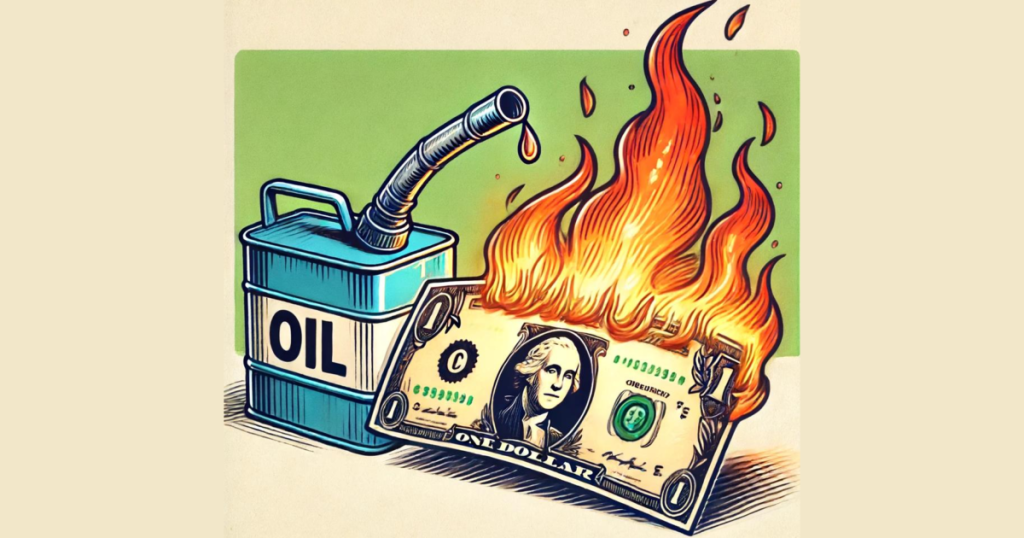The end of the Petro Dollar, courtesy of Antonio Graceffo
The internet is suddenly overwhelmed with stories about the end of the petrodollar, claiming that the US contract with Saudi Arabia to sell oil in USD expired on June 9th after fifty years.
However, no such petrodollar contract exists. Consequently, it cannot have an expiration date. The agreement was not to sell oil in dollars but to price oil in dollars and for the Saudi central bank to hold US government debt as reserves.
In return, the US provided security to Saudi Arabia and allowed it to purchase US debt at the issue price before it hit the market. This agreement has no expiration date. Articles claiming otherwise are disinformation.
The story about the end of the petrodollar is not being covered by any major media outlets but has flooded Twitter and appears on fringe websites, particularly those related to hacking, cryptocurrency, and gold.
These sources have frequently predicted the demise of the dollar for the past twenty years. The narrative is also being propagated and rebroadcast by social media accounts linked to China and various Arab and Islamic entities that support Hamas in the Israel-Hamas conflict.
This petrodollar article seems to be part of a larger campaign to discredit US achievements, including a recent spate of content challenging the Moon landings, all tied to US support for Israel against Hamas.
Many of the related articles and comments state that Saudi Arabia’s shift away from pricing and selling oil in dollars would signal the end of the US dollar as the global currency.
While this may or may not be true, such a significant shift, often described as the death of the dollar and a complete overhaul of the global economic system, should be major news.
However, the story is not appearing in any mainstream media outlets. One would expect that a looming catastrophe of this magnitude would have been reported before it happened, but most of these posts and articles have only surfaced since June 9th.
This discrepancy suggests that the narrative might be part of a broader disinformation campaign rather than a reflection of actual events.
The US and Saudi Arabia are finalizing an enhanced security deal that will elevate the US defense commitment to Saudi Arabia. Although not as extensive as the US-Japan security treaty, it includes formal guarantees to defend Saudi Arabia if attacked.
The deal provides Saudi Arabia with advanced access to US weaponry and cooperation in emerging technologies such as artificial intelligence. Additionally, it grants the US access to Saudi airspace for protecting the interests of the US and its allies.
This agreement is part of a broader geopolitical strategy that includes potential normalization of Saudi-Israeli relations and addressing regional threats, particularly from Iran. Furthermore, Saudi Arabia has agreed to halt Chinese arms purchases and restrict Beijing’s investments in the kingdom.
The conspiracy articles claim that Saudi Arabia is now free to sell oil in other currencies, but Saudi Arabia was always free to do so. They have chosen not to because other currencies are less stable and less convertible than the dollar, and this has not changed.
Over the past five years, there have been reports of Saudi Arabia discussing the possibility of trading oil in yuan, rubles, or cryptocurrencies with China, Russia, and other nations, but nothing has come of these discussions. The Saudi Riyal is pegged to the dollar, and much of its foreign currency reserves are held in US dollars and dollar equivalents.
Now that Saudi Arabia has officially joined BRICS, speculation has increased about them accepting rubles, yuan, or a synthetic BRICS currency or cryptocurrency for oil trades. However, this remains unlikely for the same reasons as before.
The ruble is a pariah currency, useless outside of Russia. The yuan is semi-convertible and semi-market, with its value largely pegged to the US dollar and controlled by China’s central bank, limiting the influence of market forces on its exchange rate.
The other BRICS partners, Brazil, India, South Africa, and now Ethiopia, have weak currencies that are largely useless outside their home countries. The UAE currency is arguably the best of the lot, mirroring the Riyal by being pegged to the dollar and backed by US dollar reserves. However, as an oil-producing nation, the UAE will not be buying oil from Saudi Arabia.
Brazil and China have discussed creating a cryptocurrency composed of BRICS currencies, but combining them would make the currency weaker than the yuan alone. Additionally, oil cannot be priced in these other currencies nor can they be used as units of account due to their fluctuations against the global currency, the dollar. Therefore, the rational choice for Saudi Arabia is to continue using the dollar.
The other parts of the agreement with the US are crucial incentives for Saudi Arabia to continue its partnership with the US. By being allowed to purchase new US government debt at the issue price, Saudi Arabia effectively receives a discount and can earn more from value increases than countries buying on the open market.
Additionally, Saudi Arabia relies on US military protection due to ongoing threats from Iran and the persistent Shiite-Sunni divide. The region’s instability, exacerbated by the Israel-Hamas conflict and Iran’s support of terrorist groups, underscores this need.
While Beijing might desire a US troop withdrawal, potentially replacing them with the People’s Liberation Army (PLA), no country has agreed to such a presence. Even Djibouti, hosting the only official overseas PLA base, also accommodates US and other international bases.
Sorry, America haters, the petrodollar is here to stay and with it, US economic and military hegemony.
The post The End of the Petrodollar? No, the Petrodollar is Here to Stay appeared first on The Gateway Pundit.







